The NVIDIA GeForce RTX 2070 Super & RTX 2060 Super Review: Smaller Numbers, Bigger Performance
by Ryan Smith on July 2, 2019 9:00 AM EST- Posted in
- GPUs
- GeForce
- NVIDIA
- Turing
- GeForce RTX
Power, Temperatures, & Noise
Last, but not least of course, is our look at power, temperatures, and noise levels. While a high performing card is good in its own right, an excellent card can deliver great performance while also keeping power consumption and the resulting noise levels in check.
| GeForce Video Card Voltages | |||||
| RTX 2070S Boost | RTX 2070 Boost | RTX 2060S Boost | RTX 2060 Boost | ||
| 1.043v | 1.05v | 1.043v | 1.043v | ||
Looking quickly at boost voltages, there aren’t any big surprises. Like the non-Super cards they’re based on, both of the new Super cards will max out at either 1.043v or 1.05v at their highest boost bin. In reality, these cards are typically not boosting quite so high due to TDP limits, in which case power consumption is often under a volt(a).
| GeForce Video Card Average Clockspeeds | |||||
| Game | RTX 2080 | RTX 2070S | RTX 2070 | RTX 2060S | |
| Max Boost Clock | 1900MHz | 1950MHz | 1875MHz | 1950MHz | |
| Boost Clock | 1710MHz | 1770MHz | 1620MHz | 1650MHz | |
| Tomb Raider | 1785MHz | 1875MHz | 1725MHz | 1800MHz | |
| F1 2019 | 1785MHz | 1875MHz | 1770MHz | 1815MHz | |
| Assassin's Creed | 1815MHz | 1890MHz | 1785MHz | 1860MHz | |
| Metro Exodus | 1785MHz | 1875MHz | 1725MHz | 1815MHz | |
| Strange Brigade | 1770MHz | 1875MHz | 1725MHz | 1800MHz | |
| Total War: TK | 1785MHz | 1875MHz | 1725MHz | 1815MHz | |
| The Division 2 | 1740MHz | 1845MHz | 1680MHz | 1755MHz | |
| Grand Theft Auto V | 1815MHz | 1890MHz | 1785MHz | 1860MHz | |
| Forza Horizon 4 | 1800MHz | 1890MHz | 1785MHz | 1875MHz | |
Meanwhile the average in-game clockspeeds largely echo NVIDIA’s official claims. The new Super cards tend to have higher clockspeeds, owing to their higher starting points within NVIDIA’s specifications. These higher clockspeeds allow these cards to punch a bit harder than they otherwise would, narrowing the gap with their RTX 2080/2070 analogs. The trade-off for this is that TDP becomes a very careful balancing act, as these higher clockspeeds are farther up on the voltage/frequency curve where the underlying GPUs aren’t quite as efficient.
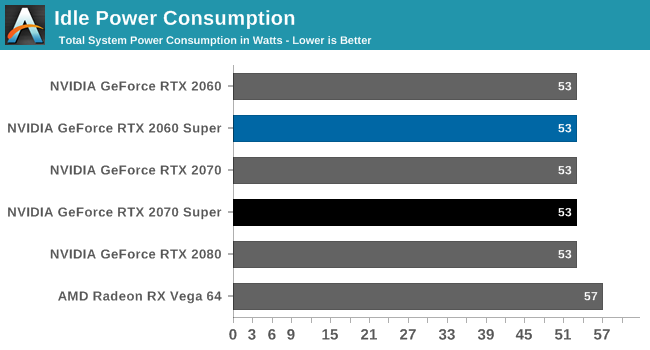
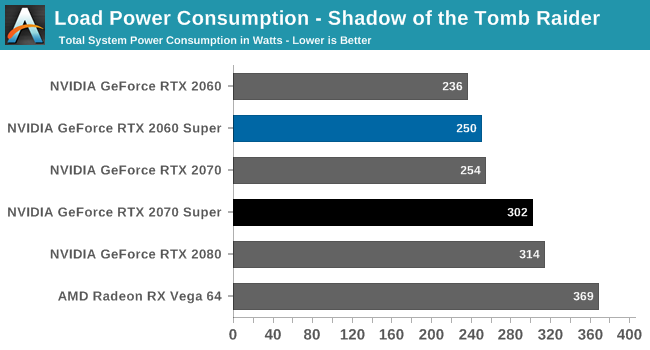
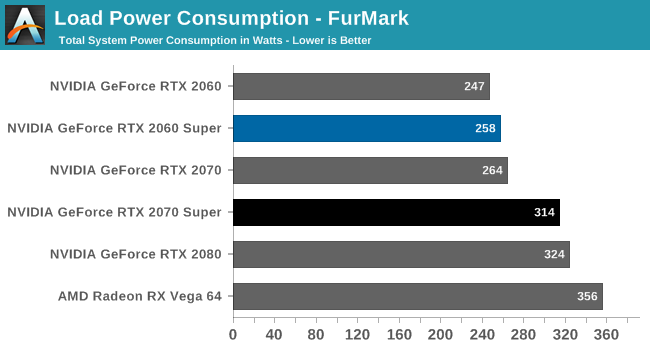
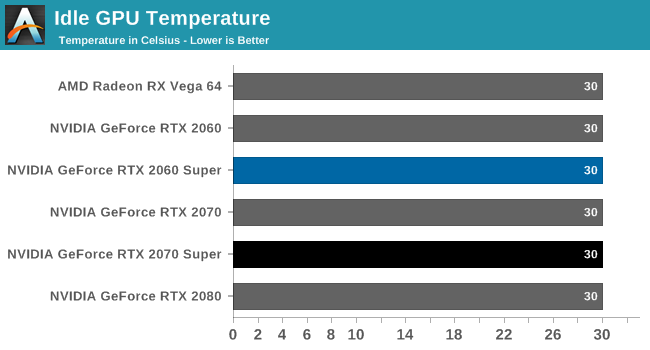
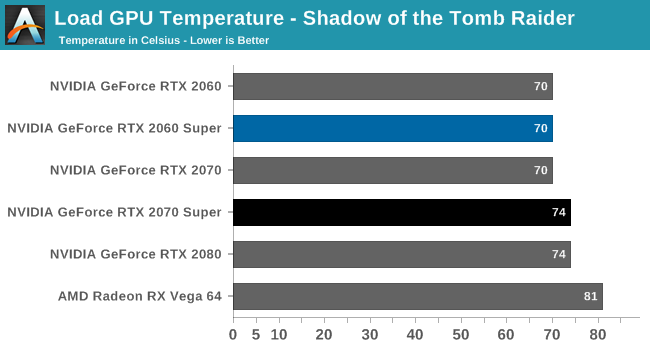
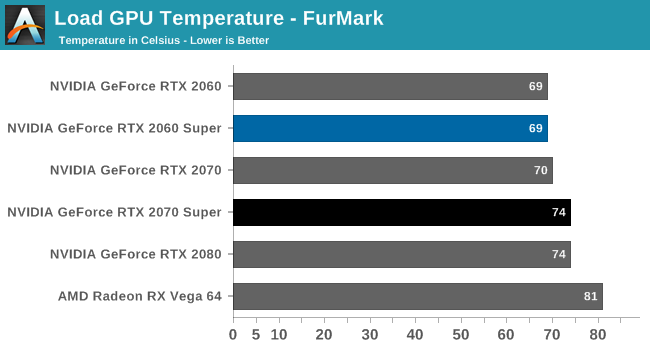
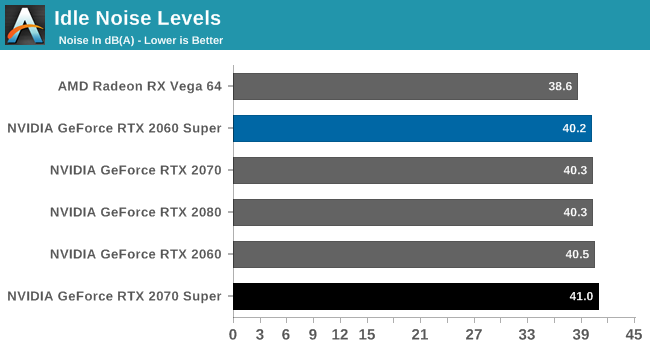
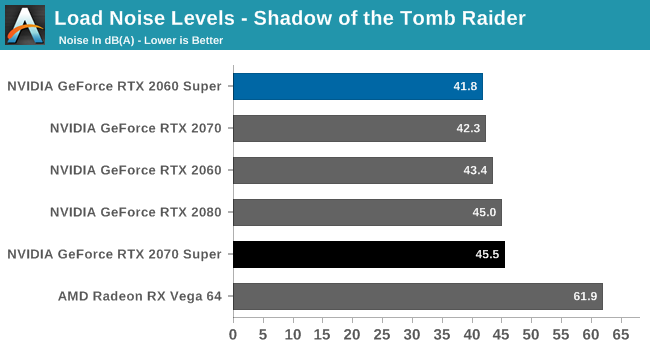
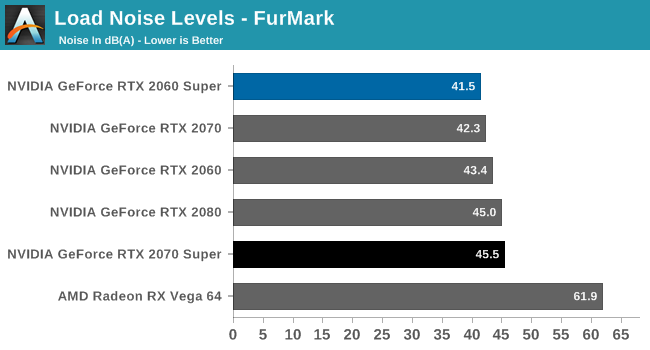










281 Comments
View All Comments
Kevin G - Tuesday, July 2, 2019 - link
I'd be foolish to jump on any of these cards right now until after the RX 5700 reviews hit. But saying that, the RTX 2060 Super does look to be one very attractive card now. The rest of the line up feels like this is where nVidia should have originally positioned the RTX line up nearly a year ago as it would have given Pascal owners more of a reason to upgrade.This does make me wonder how much longer until nVidia will have their 7 nm chips ready. If they were due at the end of the year, why not just do a small price cut if the Radeon RX line up is competitive and wait it out? If nVidia's 7 nm chips are further out, this refresh makes far more sense but has me scratching my head as to what nVidia's hold up could be. If those 7 nm chips arrive in 2020, then AMD will have had 7 nm products out on the market (though for data centers) for a full year ahead of nVidia which again seems to be weird.
sing_electric - Tuesday, July 2, 2019 - link
To be fair, you can't get the Nvidia Super cards until 7/9, after AMD's cards are out.When Nvidia launched the RTX series, I thought that they had to be pretty confident in their design to be doing it on 12nm. They probably got great yields from day 1, and I'm really surprised that they weren't able to meet demand from the time they launched.
Peter2k - Tuesday, July 2, 2019 - link
Probably the sheer size of the chips itself, thx to the RTX partsWould've been interesting to see a GTX 2080
Yojimbo - Tuesday, July 2, 2019 - link
The 12FFN process is mature and the yields are good, but the RTX cards have large die sizes because of the features they have. I think prices do tend to go down even 2 or 3 years after a node comes out. Also, I'm willing to bet that GDDR6 prices are lower now than 9 months ago.I'm pretty sure NVIDIA won't be shipping any 7 nm parts in an significant volume until the second half of 2020. At that time NVIDIA needs to deliver its next generation data center GPU for the Perlmutter supercomputer. I guess they will also launch gaming GPUs because September or October of 2020 would be around the right time for it.
As far as NVIDIA's hold up, perhaps it's the current cost of the 7 nm node. AMD has no choice but to go to 7 nm. They need the power efficiency that the new node offers and they are probably willing to pay more per transistor to get it. NVIDIA doesn't need the power efficiency at the moment, so they are more willing to keep their costs down.
V900 - Tuesday, July 2, 2019 - link
Nvidia just taped out their first 7nm design, so we can expect it in about a year. :)It’ll be interesting to see how much they’ll be able to get out of the double whammy of new architecture and new node.
And AFAIK they’ll use a denser 7nm node than AMD.
Meteor2 - Saturday, July 6, 2019 - link
I quite agree, Yojimbo. 7nm or any other process step is a means to an ends, not an end in itself. Nvidia just don't need it; AMD do.Gastec - Wednesday, July 17, 2019 - link
GDDR6 prices would be lower unless there's a "power outage" every year in July.V900 - Tuesday, July 2, 2019 - link
They just taped out their first 7nm design, so it’s about a year away. :)Korguz - Tuesday, July 2, 2019 - link
oh ??? says who ??V900 - Tuesday, July 2, 2019 - link
Reliable source. Can’t remember his name rn, but one of those industry insider honchos on Twitter.Read it over on Beyond3D forum.